Ladakh: Leh Palace, Namgyal Tsemo and Soma Gompa
Sengge Namgyal must have been a proud king when he moved into the new palace in Leh. There was probably no other structure anywhere in the kingdom of Ladakh that matched the edifice overlooking the old town of Leh. Travellers of those times praised it to no end, and called it second only to the giant Potala Palace in Lhasa.
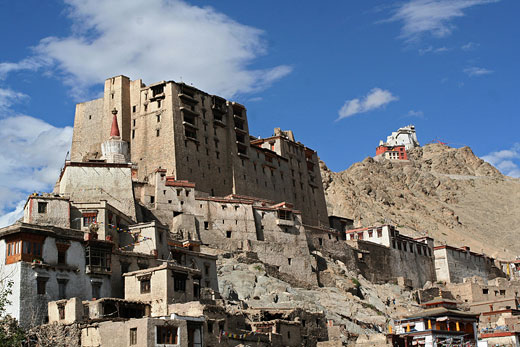
Leh Palace with Namgyal Tsemo Gompa and Tsemo Castle in the background
Everything must have been going well for Sengge. Not long after succeeding his father to become the king of Ladakh, he had conquered parts of vast Tibetan Plateau adjoining his kingdom to the west. Trade flourished in many directions – along the famed silk route to the north, with Kashmir to the west, and with Tibet to the east. His coffers were full. There were some bitter and unsuccessful conflicts with the Muslim rulers of Kashmir, but that did not affect the kingdom much. There was no reason not to splurge on a palatial structure that would dominate Leh’s landscape for next four hundred years. He so ordered for the nine-storey palace to be built on a hill just above the old town. For the royal residence, it was a remarkable improvement. The palace was more than ten times larger than the old castle built by his great grandfather.
Although there are no clear records, the palace could be dated to first half of seventeenth century, a few years before Sengge’s death in 1642. Today, it may not impress travellers coming from far away in terms of size (if you put all the marketing aside), but still remains one of the biggest structures in Leh. The mushrooming hotels in the northern part of the town are getting bigger and bigger and someone may build a hotel larger than the palace one day, but there is none so far.
I woke up before the crack of dawn one morning and walked through the maze of lanes in the old town to get to the palace. From its elevation, I could see the first light of dawn chasing away the shadow of the night and descending through the peaks of Zanskar Ranges, down to Indus Valley and then to Leh Town. The town was sleeping, but the peaceful morning was broken by the muezzin’s call for morning prayers, and later by reverberation of ‘Om Mani Padam’ from Soma Gompa.
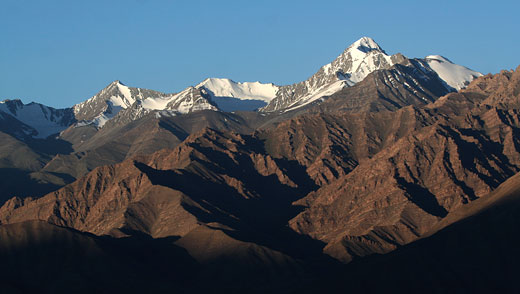
First light on Stok Kangri Peak and other mountains of Zanskar Range
My guidebook indicated that the palace is open from sunrise to sunset, like any other ASI monument. It was confirmed by a sign in front of the ticketing booth at the palace, but the booth was closed and so were the doors of the palace. I must have waited there till about 8am hoping for someone to come and open up. Thankfully the mountain vistas kept me busy during the hour of sunrise, and was later entertained by a monk who struggled for 30-minutes to kick-start his bike. Just when I was about to give up, the doors opened from inside and a sleepy-eyed man walked out. He seemed to be a worker involved in palace restoration, and must have decided to use king’s quarters to live in while he worked there. He left the door ajar and let me walk in and explore on my own.
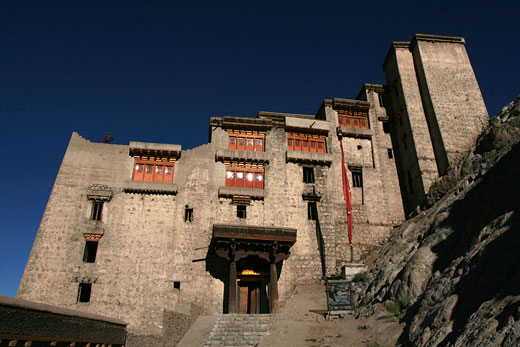
Leh Palace.
The insides of the palace were completely empty. There were no plush carpeted interiors, generous decorations and furnishing that one would look forward to see in a palace. Dark walls welcomed me in all directions, with a shaft of light appearing from one of the corners. An incandescent bulb burned somewhere ahead, letting me find my way into the heart of the palace. Along with the musty smell of oldness was a odour of restoration activity, of freshly cut wood and varnish. The palace was being spruced up by Archeological Survey of India, and there was little to see inside when I went. All that was a maze of empty rooms where I got lost several times. But up from the terrace of the palace, I was awed by the Ladakhi vistas that had impressed me all through the journey to Leh. The mountain peaks, brown slopes, the Indus River are all there to see, uninterrupted.
My meditation on the mountains was interrupted by the call of a Bactrian Magpie that sat on a perch and announced itself incessantly. Descending from the terrace, I made the slow climb further up the hill to the old castle and Namgyal Tsemo Gompa. The castle and the monastery were built by Tashi Namgyal, Sengge’s great grandfather. They are small and barely make a mark but for their location high up on a peak. It is surprising that these structures of mud and stone have weathered five hundred years and remained fairly intact. A sign near the door said ‘Tsemo Castle’, and its doors were locked up. A lone monk performed the morning puja in the monastery, where I did not spend much time inside.
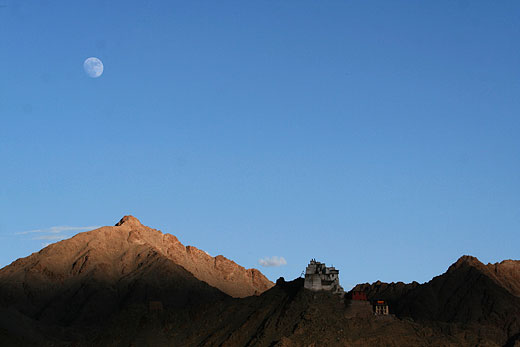
The red structure in the middle is Namgyal Tsemo Gompa. The dominating white building is Tsemo Castle
The castle was closed, but the painful climb up through a steep slope in the thin mountain air was not a waster. Wherever you are in Ladakh, climbing higher always means better views, and this was no exception.
Down the hill and into the town, I went in search of the place where I heard the chanting from the monks. Morning puja was on at Soma Gompa in the middle of the main market. Monks sat in rows and recited what sounded like continuous murmur to someone who doesn’t understand the language. The exercise was coupled with a lot of action, as they touched their nose and ears with fingers and made signs with their hands. The prayers lasted long enough that they had breaks for tea and snacks. Sitting in a corner and watching the performance, I also got my first taste of Yak Butter Tea, or gur-gur as they locally call. It is made of barley flour and salt with a generous portion of butter floating on the top. Gur-gur is not something that the tourists take a liking to, but I found it very much drinkable.
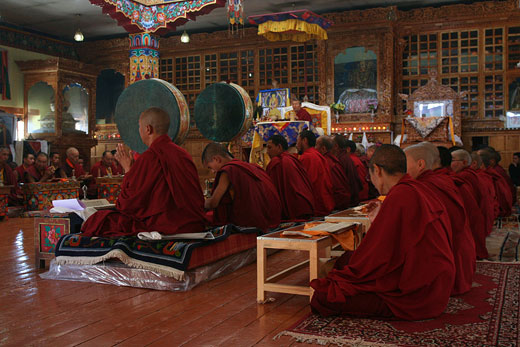
Inside Soma Gompa
Walking out of Soma Gompa and along the market, I kept looking back at the Leh Palace – the dominating building in this part of the town. I remembered expecting to find something typical to what a palace should have inside when I walked in – like plush interiors, a hall that formed king’s court, sections to seat officials at work, an area for women, king’s private quarters and so on. The Palace probably had all that, but its dark passages and the under-renovation interiors hid them away from me. I shall come back again some day when it is less challenging inside!